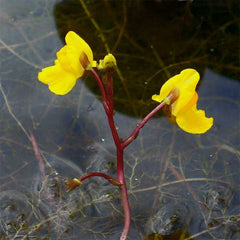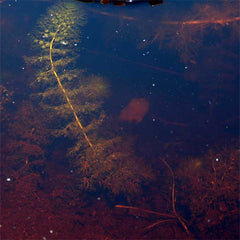
Growing Tips for Aquatic Bladderworts



Aquatic Bladderworts-Utricularia spp.
Soil: peat bottom in their water
Container: shallow water filled tub or aquarium
Watering: boggy water rich in tannins
Light: full to part sun to dappled light
Temperature: warm summer, cold winter
Humidity: 100%, submerged aquatic
Location: bog garden pool, windowsill, aquarium, greenhouse
Dormancy: temperate species: yes, form turions; tropical species: no dormancy.
Habitat
Aquatic Bladderworts, Utricularia, grow in the dark tea colored waters of boggy wetlands worldwide. Here, the water is dark brown and rich in tannins from decaying peat moss, and low in nutrients. It grows in the pond margins among floating or emergent plants such as water lilies, frogbit and pickerel weed. Species in cold climates form tight winter buds, call turions, that settle to the bottom in Winter and float back to the surface in Spring as they begin new growth. Companion Carnivorous Plants may include Aldrovanda.
Culture
Aquatic Bladderworts are easy to care for and grow if you keep their boggy water habitat in mind. Aquatic Bladderworts do best in a large aquarium or tub, 30 gallons or more, but even better in an outdoor bog pool. Add a 1-3” layer of peat moss and leaf litter to the water. Or as a neater alternative, stuff a nylon stocking with peat to about the size of a baseball or softball, and let it settle to the bottom. The peat releases tannins into the water that is critical for good bladderwort growth and reduces algal growth. Let the pool age for a week or more before introducing the bladderworts. It is important to include emergent plants in pots such as Cattail, Pickerel Weed, Water Lilies or Arrowhead Plant. Azolla is a good companion plant for floating bladderwort and is easy to grow. The leaf litter generated by these companion plants is essential to promote the growth of daphnia, protozoa and other aquatic “food.” In addition these companion plants keep algae growth to a minimum during the warm growing summer months. Bladderworts prefer warm, partially sunny, yet lightly dappled sunlight among these plants. The water can be a sphagnum peat slurry, with the bladderwort growing on the top. If grown outdoors, the pool should be deep enough so that the pool bottom is below the frost line, about 18”-24” (45-60cm) in many areas. They prefer acidic pHs between 5.0-6.8. Bladderworts need free CO2 in the water, which is provided slowly and continuously by a nice peat/sand/leaf-litter bottom. Their growth can benefit from a yeast-based CO2 generator, slowly bubbling the gas through the water. Dissolved O2 can be quite low. Good water chemistry and rich prey abundance are the two most critical factors for healthy culture. Tadpoles, small fish and herbivorous snails can be pests, but the greatest threat is often filamentous algae. Living infusoria can help control algae growth.
Propagation
Aquatic Bladderworts can be propagated from cuttings, usually at least 3 nodes long. Seeds are slow and need steady conditions.
Dormancy
Winter dormancy is required for temperate species. As day length and temperature diminish the plant will slow its growth and develop winter buds or turions at the plant tips. These will sink and over-winter in the bottom of the pool. The top of the pool may be ice covered, but the bottom should be deep enough so that the water does not freeze solid. In early Spring as the water warms, the turions will begin growth and the plants will float to the surface, often before other plants begin spring growth. For indoor culture, the turions may be kept in a peat slurry in the refrigerator.
Feeding
Aquatic bladderwort traps are under water and quite small. Their common “foods” are daphnia, mosquito wigglers, and protozoa. Catching abundant prey is a significant growth factor. They do a marvelous job of attracting and catching prey all on their own when provided with an adequate supply.
Other Considerations
Aquatic bladderworts do not compete well with algae. Acidic peaty water and companion emergent plants will help reduce this problem by maintaining a strong infusoria culture. Aquatic bladderworts can be grown in an aquarium on top of a peaty slurry as long as the plant stays wet. On occasion the water level may go low in a pool or tub, but the bladderworts can survive extended periods if kept wet. Consider growing bladderworts outdoors. They grow exceedingly well in a bog pool in the yard. They can devour mosquito wrigglers.
